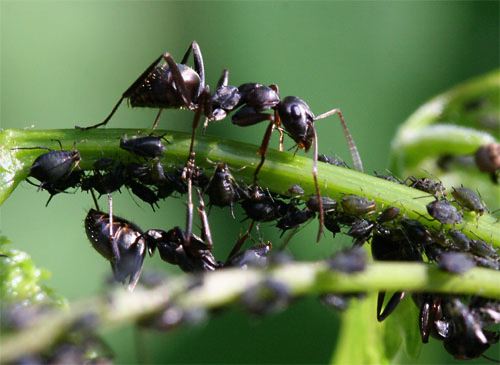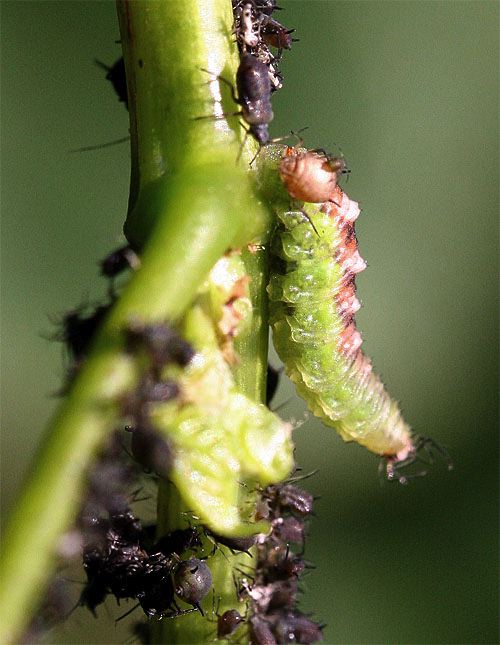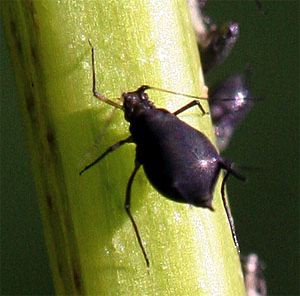|
|
|||
|
(Back to Preceding Week; on to Next Week) |
|
|
|
LION AND TIGERS AND BEARS?
OH, NO! IT'S APHIDS AND LARVAE AND ANTS! Sometime before 1982--when we purchased and moved to property that is now Hilton Pond Center for Piedmont Natural History--someone planted a Forsythia in an open expanse between the rear of the old farmhouse and the pond itself. Although this yellow-flowered shrub isn't native, we allowed it to remain. These days the tree canopy has grown so thick the Forsythia seldom blooms, but it devotes quite a bit of energy to propagating itself vegetatively--to the point it is now a thicket 15 feet wide by 30 feet long by 5 feet tall. In spring and summer the thicket provides nesting spots for Eastern Towhees and Brown Thrashers, and in winter even the most agile Sharp-shinned Hawk has trouble getting at White-throated Sparrows, Northern Cardinals, and Dark-eyed Juncos as they frantically flee through our rambling Forsythia's tangled stems.
All text & photos © Hilton Pond Center Lest this vigorous shrub take over the entire yard, in recent years we've resorted to whacking back the Forsythia and wild grape that has begun to share its plot (at lower right in photo above). This week when we were pruning we bumped against the thicket and felt a sharp pain in the right hand. OUCH! Was the thicket now home to lions and tigers and bears? Oh, no, but crawling along a grape vine was a half-inch-long insect--a black ant (Formica sp.) with pinching mouthparts that caused our temporary irritation. Looking more closely we saw the ant had good cause to bite: It was helping guard a herd of sap-sucking aphids--tiny insects whose sweet honeydew excretions are eaten by ants. And as we got even closer we spotted a couple other organisms in the mix--what appeared to be little green caterpillars about the size of the ant. This Forsythia thicket at Hilton Pond Center housed a menagerie all right, but rather than big carnivorous mammals it held aphids and larvae and ants!
Before reading further. We hope you'll take a moment to scroll back up and study the photo just above, looking carefully at each of the three kinds of organisms represented. Finished? Okay, then let's proceed. When we came across this aphid/larva/ant scenario we understood some of it--after all, aphid-tending by ants is a well-known phenomenon--but we couldn't figure out what the caterpillar was doing. Why hadn't the ants killed or eaten this little green larva? We did some reading and learned some caterpillars are able to control ant behavior so the ants accept the larva and protect it from predators. Is that what was going on in this photo? To get better answers we turned to Entom-L and BugNet, two listservs whose members are most helpful in explaining things entomological. The responses we received showed our interpretation of the ant/aphid/larva relationship wasn't quite what we had thought. In fact, we weren't even seeing what we thought we were seeing.
There was no question we had encountered ants tending aphids. This behavior is depicted in the photo above in which two ants are moving back and forth on top of and beneath the grape vine, stroking the aphids with their antennae and keeping on the lookout for intruders. But it turns out the green larva isn't a caterpillar after all.
Through the camera lens--and even after we had studied the image above on our computer screen--we mistakenly believed we were looking at some sort of moth or butterfly caterpillar. We imagined it had a large tan-colored head with protective spikes--not an unusual ornamentation in the world of caterpillars--but we were mystified by the spiny black appendages on its posterior end. Boy, were we fooled! Entom-L listserv member and writer/illustrator Eric Eaton was first to point out--kindly and gently--this organism wasn't a caterpillar at all. It WAS a larval stage but would develop not into a butterfly or moth but one of the syrphid flies, better known as Hoverflies or Flower Flies (below right). The syrphid fly larva--a maggot--is a bit different from caterpillars in that the small, pointed end is the "business end"; i.e., that's where the head and mouth are located. Had we paid better attention, we would have noted our little fly larva (like caterpillars) had numerous prolegs, i.e., "false clasping legs" that help grip; these always occur POSTERIORLY along the abdomen rather than on the anterior end. And what we imagined were black, spiny anal appendages were actually the legs of an aphid being consumed by the predatory syrphid fly larva, holding its victim high and draining it dry. Boy, do we feel dumb! What makes us feel even dumber is what we had thought was the tan-colored head of the fly larva was actually the body of a dead aphid, bloated and discolored. Eric explained this aphid "mummy" likely now contained the pupa of a braconid wasp-- Now that we understood what we were REALLY looking at--Formica ants, aphids, and fly larvae--something was still confusing. We could understand how a braconid wasp laying her egg on an aphid might escape being detected or captured by a guard ant--after all, the speedy wasp has wings and is about aphid-sized--but why in the world would an ant tolerate the slow-moving green maggot of a syrphid fly among its aphid herd? The answer to this mystery came from a couple of listserv members, but Elsa Youngsteadt of North Carolina State University sent a copy of a paper about her work on this general topic. In Elsa's words, "the maggot is chemically camouflaged among the aphids, i.e., its cuticle or the surface of its body has taken up the same stuff that's on the aphids, so the ants can't tell them apart. Ants tend to trust what they can 'smell' more than what they see, so if the maggot smells like aphids, the ants won't bother it--even though they probably try to defend the aphids from predators in general." So there you have it. Our backyard Forsythia patch is NOT home to lions and tigers and bears, but it does house a very complex relationship between aphids, fly larvae, and ants--and parasitic wasps to boot. This all goes to show we could spend ten lifetimes studying and taking photos while hardly beginning to understand all the wonders of nature that abound at Hilton Pond Center. All text & photos © Hilton Pond Center
Comments or questions about this week's installment?
Thanks to the following fine folks for recent gifts in support of Hilton Pond Center for Piedmont Natural History and/or Operation RubyThroat: The Hummingbird Project. Your tax-deductible contributions allow us to continue writing, photographing, and sharing "This Week at Hilton Pond." (Please see Support if you'd like to make a gift of your own.)
IMPORTANT NOTE: If you ever shop on-line, you may be interested in becoming a member of iGive, through which nearly 700 on-line stores from Barnes and Noble to Lands' End will donate a percentage of your purchase price in support of Hilton Pond Center and Operation RubyThroat. We've just learned that for every new member who signs up and makes an on-line purchase within 45 days iGive will donate an ADDITIONAL $5 to the Center. Please sign up by going to the iGive Web site. It's a painless and important way for YOU to support our work in conservation, education, and research. "This Week at Hilton Pond" is written & photographed You may wish to consult our Index of all nature topics covered since February 2000. You can also use our on-line Hilton Pond Search Engine at the bottom of this page. For a free, non-fattening, on-line subscription to |






 an obviously small parasite that lays its eggs on living aphids like the one in the photo at left.
an obviously small parasite that lays its eggs on living aphids like the one in the photo at left.

 Please report your
Please report your
